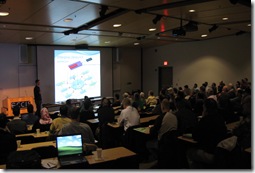Windows Azure for Architects - Northeast Roadshow Recap
  |
It was a pleasure to get back out on the road with Chris and Jim and see all the folks who
I've listed additional resources below for your future Azure Discovery Adventures. Enjoy! -bob |
Resource |
Description |
| Above the Clouds - Berkeley | Cloud Computing refers to both the applications delivered as services over the Internet and the hardware and systems software in the datacenters that provide those services. The services themselves have long been referred to as Software as a Service (SaaS). The datacenter hardware and software is what we will call a Cloud. When a Cloud is made available in a pay-as-you-go manner to the general public, we call it a Public Cloud; the service being sold is Utility Computing. We use the term Private Cloud to refer to internal datacenters of a business or other organization, not made available to the general public. Thus, Cloud Computing is the sum of SaaS and Utility Computing, but does not include Private Clouds. People can be users or providers of SaaS, or users or providers of Utility Computing. We focus on SaaS Providers (Cloud Users) and Cloud Providers, which have received less attention than SaaS Users. |
| Windows Azure Site | Build new applications in the cloud - or use interoperable services that run on Microsoft infrastructure to extend and enhance your existing applications. |
| Windows Azure Developer Center | The Microsoft Azure Services Platform is an Internet-scale cloud services platform hosted in Microsoft data centers. The Azure Services Platform includes an operating system, Windows Azure, and a set of developer services to be used individually or together: .NET Services, Live Services, and SQL Data Services. |
| Azure SDKs | The Windows® Azure SDK provides developers with the APIs, tools, documentation, and samples needed to develop Internet-scale applications that run on Windows Azure. Using the Windows Azure SDK, developers can create applications and run it in a local development fabric even without a registered account. |
| "How do I..." videos | On this page you will find webcasts and how-to videos covering the technologies included in the Azure Services Platform: Windows Azure, .NET Services, SQL Data Services, and Live Services. |
| Cloud Computing Tools | Windows Azure Tools for Microsoft Visual Studio extends Visual Studio to enable you to create, build, debug, run, and package scalable services on Windows Azure. |
| Community | Windows Azure Blogs and Forums |
| Cloudy in Seattle Blog | Jim Nakashima blog: excellent resource of Azure samples |
| Bruno Terkaly Blog | Great resource on understanding how to work with the developer fabric, role manager, etc. |
REST support within WCF was enhanced with the release of .NET Framework 3.5 SP1 to add make REST development easier and to support the ADO.NET Entity Framework entities in WCF contracts. Improvements were made around UriTemplate flexibility and the Visual Studio tooling to increase developer productivity. |
Technorati Tags: Windows Azure,Cloud Computing,Architecture,Azure Services Platform,Visual Studio
Comments
- Anonymous
March 23, 2009
PingBack from http://blog.a-foton.ru/index.php/2009/03/23/windows-azure-for-architects-northeast-roadshow-recap/
